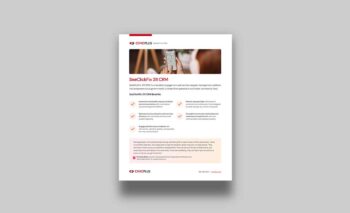Is Your Legacy 311 Process Working Against You?
Modern 311 request management systems should help governments respond faster, serve more equitably, and more easily earn resident trust. However, when long lines, never-ending phone trees, and stacks of paper requests get in the way, your 311 request management process can actually become a barrier to effective service delivery, rather than a solution for it.
Here are five signs your municipality’s 311 service request process may be doing more harm than good, and how to fix it.
Sign 1: Residents Voice Displeasure with Quality of Life/Public Spaces
If your 311 request management process is manual, clunky, confusing, or buried under stacks of paper, residents and staff alike will avoid using it. And that means more frustration, turnaround delays, and an erosion of public trust.
To make matters worse, in today’s age of easily accessible information, social media and the press can exacerbate any growing negative public sentiment. In addition to facing increasing public relations challenges in the media, local government officials also have less time to address concerns due to increasing resident service and communication expectations.
If your residents are upset and don’t feel they have reliable channels of communication, they will find other ways to make sure they are heard.
How to fix it:
- Offer simple, mobile-friendly web and app intake with plain-language categories.
- Capture exact location (GPS/map pin) and photos in one step.
- Auto-confirm submission and set expectations for next steps and timelines.
Sign 2: Departments Are Siloed and Requests Are Falling Through the Cracks
Email inboxes and spreadsheets create the “black hole effect:” Duplicate entries, unclear ownership, missed follow-ups, and no end-to-end visibility—especially across public works, parks and recreation, and utilities departments. Research from Cornell on 311 open data highlights quality/consistency challenges that, if unmanaged, ripple into workflow misalignment.
High-quality, consistent 311 data is an asset. When fields are standardized and validated, you get apples-to-apples metrics across departments and years, enabling dashboards that surface hotspots, equity gaps, and return on investment (ROI). Reliable histories let you target crews, forecast demand, and defend budgets, and residents see trustworthy status updates that build confidence.
And because the data is clean and well-documented, it can power automation and machine learning (ML) functionality—like duplicate detection, data analysis and severity scoring. In short: Investing in data quality unlocks faster responses, fairer outcomes, and credible accountability.
How to fix it:
- Standardize fields, statuses, and value domains across departments (baked into your 311 request management system) for apples-to-apples reporting over time.
- Centralize intake and routing with shared queues, service level agreements (SLAs), and timestamped handoffs; use auto-assignment and escalations.
- De-duplicate via location/asset and description matching, and maintain a single shared case history that residents can see.
Sign 3: Your Team Has No Way to Prioritize Requests Strategically
If requests arrive as walk-ins, phone calls, or generic emails, triage slows and urgent issues blend in.
A 2025 field experiment in Calgary using a randomized design found that issues submitted through the 311 service request system were about 26 percentage points more likely to be resolved within 3–10 days, with no drop-off in less-advantaged neighborhoods. In short, centralized, structured intake makes problems visible and routable—so the right work gets prioritized fast.
How to fix it:
- Capture structured data at the front door: Require key fields (e.g., category, GIS pin, photos) across web, mobile, text, and phone—operators enter calls directly into the 311 request management system so everything lands in one queue.
- Optimize triage: Use rules and automations to categorize requests, set severity, and route by location, asset, and SLA targets; escalate when timelines slip.
- Run the day on live dashboards: Surface “today/this week” priorities, SLA-risk, and backlogs; track resolution lift to prove impact.
Sign 4: Residents Don’t Know What’s Happening After They Report Something
In many communities, 311 service request submissions feel like a black box, where residents submit a request and then get a stock closure note weeks later (e.g.,“No evidence observed”) or nothing at all. That lack of reliability undermines trust and discourages future reporting.
The irony is that 311 service request reporting is also a “people’s dataset,” where residents’ reports can spotlight neighborhood needs and even fuel advocacy. But without clear status, handoffs, and outcomes, the experience feels impersonal and unresponsive.
How to fix it:
- Make the pipeline visible: Show where a request is in plain language—Received → Routed to Agency/Unit → In Queue → On-site Attempt → Resolved—with timestamps, responsible team, and meaningful closure reasons (not generic codes), plus photos/evidence.
- Communicate like a modern service: Send automatic, multi-language updates on receipt, assignment, in-progress, on-site attempts, and resolution. Enable two-way messaging and prompts to add photos or details when “no evidence” is recorded.
- Publish and teach: Offer a public tracker and open status feed, display satisfaction trends, and provide “How 311 requests work” guides through community boards and local orgs so residents know who handles what and how to follow up.
Sign 5: You Can’t Show Progress (or Justify Budget)
If you can’t report on volume, time-to-first-action, on-time resolution, backlog, and equity by neighborhood, it’s hard to defend budgets or target resources. As mentioned previously, 311 service request data is increasingly used as a “people’s dataset” for transparency and accountability, and inequitable service—like slower cleanups in certain neighborhoods—can trigger civil rights scrutiny (as seen in Houston, with a DOJ agreement announced June 7, 2023).
How to fix it:
- Standardize metrics, like intake-to-assign, assign-to-resolve, reopen rate.
- Track performance by neighborhood/ward and publish trends.
- Monitor equity KPIs (response times, closure rates) and adjust resources proactively.
Don’t Let Outdated 311 Request Management Processes Become a Liability
If these signs sound familiar, it’s time to modernize with SeeClickFix 311 CRM. You’ll get:
- Smarter intake and routing: Structured forms, GIS mapping, duplicate detection, and automated assignment.
- Transparent communication: Real-time status updates, notifications, and closure surveys residents can trust.
- Powerful Integrations: Connect seamlessly with existing systems through dynamic bi-directional integrations, including GIS, code enforcement, asset management, and enterprise CRMs.
- Actionable reporting: Dashboards for SLAs, trends, and equity metrics to guide budgets and staffing.
Request a demo to see how your 311 request management process can work for you—not against you.
Ready to Learn More?
CivicPlus provides a one-stop tool to receive, track, and respond to resident service requests.


